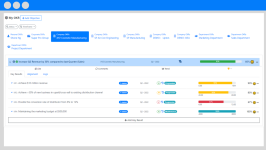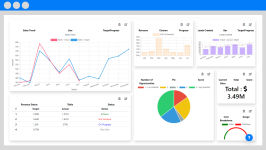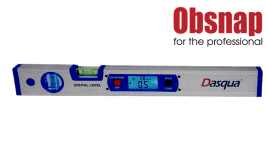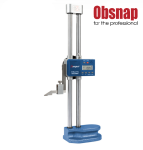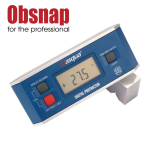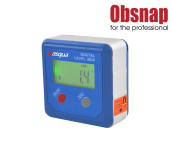Obsnap Instruments Sdn Bhd
29A, Jalan SS 15/4C, 47500 Subang Jaya, Selangor, Malaysia.
Latest News
Hari Raya 2019
Jun 3, 2019From, Obsnap Group of Companies
NOTICE:
- We are closed on 5 to 7 th Jun 2019 (Wednesday to Friday)
- We'll be back on 10 th Jun 2019 (Monday)

When to Calibrate
Jun 3, 2019
When is Calibration Due?
Calibration is crucial to adjust and maintain the accuracy and precision of measuring & testing instruments.
The manufactured quality of the components, parts and products produced is determined by the calibration done on them. To ensure consistency and reliability of the measuring equipment.
When?
The general recommendation is an interval 12 months period.
How Often?
It depends on the:
- Application & Overall Usage of the Equipment / System
- Manufacturing or Industrial Requirement of Calibration Frequency
-
Operating Conditions of the instrument’s:
- Wear & tear process
- Frequency & severity of usage
- Temperature & environmental exposure
- Historical records of the measurement’s stability, consistency & accuracy
- Specifications & Installation of your products & services
Risks of not Calibrating?
Calibration is an industrial standard to ensure the safety, quality and consistency of ISO 9000 & MS ISO 9001 manufactured products.
A measuring instrument’s reading cannot be assured; that can lead to inaccuracies with the overall product / service quality. Making it more costly to do the rework than the frequent cost of calibrating an equipment.
For ISO 17025 Calibration / Consultation :
Ms. Sitee Nuraihah Zohari, Calibration Strategist
MOBILE : +6011-1186 9979 | OFFICE : +603-5621 5786
EMAIL : cal.sales2@obsnap.com cc marketing@obsnap.com
URL : Obsnap Calibration Services
Full List - Scope of Capabilities || ISO / IEC 17025 Certification || ILAC Approval Letter

Brought to you by, Obsnap Calibration Sdn Bhd (1222585-W) which have served over 500+ companies from:

View our full list of clients HERE.
Choose the Right Heat Treatment Furnace
May 30, 2019Choose the Right Heat Treatment Furnace

“Picking the most suitable furnace for industrial application require knowledge of the factors & processes needed for the manufacturing & production lines.“
An industrial furnace go up to 1000°C - 1200°C or higher. Allowing manufacturers to use for its heating & cooling capability on various materials (e.g. metals) to change their quality and properties to meet with industrial or market standards.
BENEFITS
Why do manufacturers need such a high temperature?
- Alter or fabricate the physical or chemical properties of a material.
- Change the grain structure or mechanical properties of a material so that it becomes useful, serviceable and for human safety during and after the production line operations.
- Making materials harder, stronger and more resistant to impact or softer and ductile.
- Increase resistance to wear, tear, heat, corrosion, etc.
- Improve electrical and magnetic properties (for metals)
One furnace cannot produce all of this characteristic or result as mentioned so manufacturers have to use different types of heat treatment methods and furnaces to achieve the desired results.
FACTORS TO CONSIDER
- Purpose for which type of material needs to be heated
- Source of heat and the Nature of heat transfer to the material
- Heating by batch or continuously and the method of handling materials
- Type of heat recovery
- Other types of furnace classifications
HEAT TREATMENT TYPE TO CONSIDER
1. Preheating
- Helps to increase the temperature of the material slowly for the control of the thermal stress.
- Prevent or reduce chances of the material to crack, contract, or expand (from thermal stress).
2. Annealing
- Removes thermal stress by heating up then slowly cooling down the metal.
- Capable of making the material softer, refine, or change its ductility or structure.
3. Hardening
- Heats up the material with a high temperature and then follow up with quick cooling process (by quenching in water, oil, or molten salt) to increase material’s resistance to penetration (hardness).
- After this heat treatment, tempering or annealing can be used to slightly modify the material’s quality and characteristics.
4. Tempering
- Involves slow and moderate heating to increase the hardness and toughness of the materials e.g. metals that have undergone previous heat treatment.
- Improve toughness, strength, plasticity, and impact strength of the materials (opposite of annealing)
The above are only a quarter of heat treatment application available in the industrial market and methods.
SUITABLE INDUSTRIES FOR HEAT TREATMENT
Arts & Crafts | Aircraft | Automotive | Additive Manufacturing | Dental | Forging | Foundry | Glass | Heavy machinery | Manufacturing | Metals parts | Laboratory | And many more

Brought to you by, Obsnap Instruments Sdn Bhd (599642-A)
Need Consultation or Heat Treatment Equipment?
Contact our Product Specialist, Mr. Zaheem
+60 12-989 6820 (Whatsapp link) | sales12@obsnap.com
cc Marketing Support, Ms. Kan,
+6018-221229 (Mobile Whatsapp link) | emarketing@obsnap.com


Pendulum Impact Testing - June 2019
May 27, 2019
“A material's toughness determines if it is suitable to be reused for production or to improve its manufacturing quality for their end-product.” |
Pendulum Impact testing is a type of mechanical testing used to study the toughness of a material to check the product's ability to absorb impact and to analyse the deformation process before fracturing (by using a falling pendulum weight or striker to determine a product's ductile to brittleness *).
*Common brittle testing samples are glass, wood, plastic, paper and dried clay (low toughness and can be deformed easily) while duxtile items are aluminium, copper, tin, mild steel, platinum and lead (high toughness and will not fracture easily).
Benefits of Pendulum Impact Testing
- Determine the material's ability to absorb energy during a collision by testing raw materials and molded components for strength and durability.
- Understand the impact strength, anti-fracture, impact resistance, degradation, damage of the materials and a product's lifetime responses to wear & tear.
- Prevents the future production quality failure (provide analysis for future designs)
- Investigate batch quality during the raw material’s creation.
Common pendulum impact test methods :

Both testing methods are used to check the impact resistance with the pendulum method but with some differences.
Charpy impact testing
- Test materials are placed horizontally
- Hammer strikes at the middle point of the notch (surface) but in the opposite direction.
- Can test on metals, plastics and polymers.
Izod impact testing
- Test materials are placed vertically.
- Hammer strikes at the upper tip of the specimen.
- Can test on metals and plastics
Applications of Pendulum Impact Testing
Plastic | Metal | Education Sector | Research & Development
And Many More!
Need advice on Pendulum Impact Testing Equipment / Service?
Reach out to our expert today for a professional recommendation.


Alvin George, Product Specialist
+6012-2232593, sales11@victormaterial.com cc marketing@obsnap.com
Material Testing Equipment and Services
- For VICTOR Material Testing Equipment via www.victormaterial.com
- Our list of VICTOR Services at www.victortestingmachine.com
Other Products & Services
- MS ISO / IEC 17025 Calibration Service
- Equipment & Instruments Repair & Maintenance
- List of Metrology & Material Testing Equipment
Colour Consistency- May 2019
May 24, 2019
How to Measure Colour for your Business

Having trouble with visual colour checking? Need accurate colour reading?
Before colour is painted, printed and produced, manufacturers have to ensure that colour is monitored and accessed during the design stage, the formulation & production process and finally during the quality control process. Which determines the overall outlook on the products while attracting customers…
After the product assembly, final quality checks are done to identify and if needed, fix the colour issue. This is less expensive than doing rework on your goods after a rejection call.
There are many ways to identify & categorise colours, which includes:
Visually / Manually

- By comparing the product’s colour with a known standard (e.g. Pantone ®, Munsell, etc..)
- Open to errors and disagreement with your customers and suppliers. Because it requires properly trained people to visually evaluate color while doing it under different lighting conditions can affect assessments.

Using a colour meter or colourimeter
- A portable device that is able to read and provide tri-stimulus (RGB) values (uses an internal light source, to shine light down onto the surface of the sample and as it reflects back up to the device, it passes through three filters: red, green and blue), similarly to how our eyes see colours.
- Cannot detect metamerism (evaluating when two colors appear to match under one lighting condition but not when the light changes) rendering it unsuitable for all production applications e.g. formulation.

Using a spectrophotometer
- Works similarly to a colourimeter but instead of using only 3 filters (RGB values) there is 31 filters to measure the full colour spectrum value. These filters can measure light in each of 31 different wavelengths to determine the exact colour of a sample.
- Come in many shapes and sizes - small handheld devices, large benchtop workhorses and in-line devices used during manufacturing production.
- Ideal for identifying metamerism (evaluate how colour will look under different light sources
- Can measure almost anything from liquids, plastics, paper, metal, fabrics, etc.
Applicable industry:
Automotive | Aerospace | Components & Parts | Electrical and Electronics | Furniture | Graphic Design | Marine & Maritime | Printing | Packaging | Photography | Pharmaceuticals | Paints | Plastics, Rubber and Elastomer | Steel | Textiles

Brought to you by, JS Analytical Sdn Bhd (1094207-V)
NEED CONSULTATION ON COLOUR MEASURING EQUIPMENT?
View our list of Colour Measuring Systems, visit our website
Reach out to our expert today for a professional recommendation.
Elton Wong, Product Specialist,
+6012-292 2371, sales11@jsanalytikal.com cc marketing@obsnap.com
Happy Wesak & Nuzul Al-Quran 2019
May 15, 2019From, Obsnap Group of Companies
NOTICE:
- We are closed on 20th & 22nd May 2019 (Monday & Tuesday)
- We'll be back on 21st & 23rd May 2019 (Tuesday & Thursday onwards)
|
|
|
METALTECH 2019
May 9, 2019
Dear Sir or Madam,
Obsnap Group of Companies is proud to present:

It is an honour for us to invite you to visit the 25th International Machine Tools and Metalworking Technology Exhibition. This will be our 16th exhibition together with METALTECH.
Exhibition Details:
METALTECH is the ideal platform for industry leaders and decision makers to gather and stay abreast of the latest developments. The prominent exhibition is once more expected to draw a record turnout, with 2,000 participating companies over 25,000 sqm of gross exhibition space projected to pull in close to 20,000 regional and international visitors over the event’s four-day duration.
| Opening Hours: | Wednesday – Friday, 15 – 17 May 2019 (10:00 am – 7:00 pm) Saturday, 18 May 2019 (10:00 am – 6:00 pm) |
| Venue: | Malaysia International Trade & Exhibition Centre (MITEC) Kuala Lumpur, Malaysia |
| Booth No. & Hall: | 2006 & 2007, Hall 2 (Booth Floor Plan, below) |



Benefits of Visiting:
- See more than 700 exhibitors for networking
- Compare the technical characteristics of equipment and machinery from the leading producers;
- Explore a competitive environment and see all latest developments from industry leaders;
- Get the advice of the experts about the introduction of new technologies in food packaging, plastic, mold and die engineering.
Want an e-invitation card from us?
Click the image below to download
If you have any inquiries on this exhibition, email to marketing@obsnap.com
We look forward to your visit!
Melt Flow Testing ĘC An Introduction
May 2, 2019|
Melt Flow Testing – An Introduction |
Suitable items for Calibration...
Apr 30, 2019
Having Trouble Viewing? See Original Post HERE.
|
Suitable items for Calibration...
By regularly calibrating measurement equipment and monitoring their performances and end result. This ensures that the measuring instrument can conform to :
After proper calibration, satisfaction is guaranteed while improving a company’s reputation in productivity, eliminating wastage and saving cost. Industrial Equipment that can be calibrated : Depending on the application, there are many other measuring & testing instruments that can be calibrated. Automotive / Metal : Coating Thickness Meter, Hardness Tester, Micrometer, Surface Roughness Meter & etc.
Construction / Civil Engineering : Sound Level Meter, Laser Distance Meter, Digital Measuring Tape & etc.  
For Scientific & Research Division on temperature testing : Digital / Infared Thermometers / Thermocouples, Humidity Chambers, Thermo Hygrometer & etc.
For Pressure, Flow and Hydraulic Calibration with ISO 17025 : Barometers, Pressure Gauges, Dead Weight Tester & etc.  
For Mechanical Measuring Equipment : Load Cells & Force Gauges Micrometers, Verniers, Height Gauges Scales / Weight Balances & etc.
Ms. Sitee Nuraihah Zohari, Calibration Strategist Full List - Scope of Capabilities || ISO / IEC 17025 Certification || ILAC Approval Letter
Brought to you by, Obsnap Calibration Sdn Bhd (1222585-W) which have served over 500+ companies from:
|
Avoid Plastic Deformation ĘC Dry your Resins!
Apr 29, 2019

“Even moisture levels of 0.07% can cause cosmetic problems on a part surface if the material is exposed to the temperatures of melt processing…” - Michael Sepe (independent materials and processing consultant)
Plastic Deformation (e.g. mould, holes, bumps, etc.) appears when plastic resins go through the production line without drying properly, thus affecting its overall quality.

(Above) Images of deformed plastic products i.e. spoon, bottle and panels.
How to get the unwanted moisture out?
“In most plastics processing plants, resin dryers are a standard piece of equipment. Drying is a necessary preparative step to prevent this defect (material being moulded due too much moisture).” - Michael Sepe
In order to avoid the moisture turning into air bubbles when going through the hot-melt extrusion machine, the resins has to pass through a drying machine beforehand to be preheated to get the moisture out.

(Above) How a drying machine create pre-heating condition to release the moisture out plastic resins to create steam then rejecting the collected moisture away from the raw material.


Benefits of using drying machine:
- Stabilises the production parameters
- Reduce processing energy costs
- Ensure maximum polymer performance
- Preventing Cosmetic Problems aka splay or silver streaking.
- Preventing Hydrolysis (chemical reaction that breaks the covalent binds in the polymer chain, reducing molecular weight of the polymer and significantly reducing mechanical properties.)
- Preventing Part Failure (after drying, if the appropriate moisture for processing is not reached, premature part failure and structural defects can occur.)

Brought to you by, JS Analytical Sdn Bhd (1094207-V)
Want to improve your Plastic Feed Processing System?
|
|
|
|
We can develop solutions for specific, specialist applications. From injection and blow moulding, to extrusion, compounding and in-line systems through to chemical processes for granulate, pellets, powder, dyes and liquids and always tailored to meet your requirements.
Visit our website for more info: Plastic Manufacturing Processing
Contact Details :
Ms. Charan, Product Specialist
+6019-399 2576 / sales12@jsanalytikal.com cc marketing@obsnap.com
Happy Labour Day 2019
Apr 29, 2019fellow labourers! Have a good break!
From, Obsnap Group of Companies
NOTICE:
- We are closed on 1st May 2019 (Wednesday)
- We'll be back on 2nd May 2019 (Thursday)

Withstanding the Heat Wave in Malaysia
Apr 9, 2019|
Withstanding the Heat Wave in Malaysia
“Will your product still be reliable in different countries of various humidity? Can your product still operate well after unexpected / sudden heat exposure?” On January 2019: Adelaide, Australia had reached — a searing 46.6 C (115.9 F) on record on Jan. 24. Chicago was recently hit with Polar Vortex, recording the lowest temperature ever at -38°C. Malaysia has recorded temperature as high 37°C during recent the heat wave. How to Check the Weather Tolerance of your Products? One of the ways that R&D and QA / QC analyses how their products will react to environmental change or sudden climatic exposure is by using a weather simulation system e.g. climatic testing chamber… What is a Climatic Testing Chamber? Also known as the environmental test chamber, are enclosed chambers specialise in testing the tolerance level of items, materials & components, when exposed to specified environmental conditions.
Temperature & Humidity Chambers
BENEFITS :
Brought to you by, Obsnap Instruments Sdn Bhd (599642-A)
Need Environmental Testing Solution?
Mr. Eddie Ridzwan Lee, Sales & Application Engineer :
cc to Ms. Kan, Marketing Support : OTHER SERVICES ISO / IEC 17025 Calibration | Testing & Measuring Products | Repair & Maintenance | Material Testing Services
|
WHY USE TENSILE TEST?
Mar 29, 2019|
THE PURPOSE OF TENSILE TESTING |
Calibration: Accuracy & Consistency
Mar 28, 2019CALIBRATION: ACCURACY & CONSISTENCY
.jpg)
'It is better to record accurate or precise measurements?'
The Difference:
If you weigh yourself on a scale three times and each time the number is different, yet it is getting closer to your true (actual) weight, the scale is accurate.
However, when it comes to scales that provide precision, it can be precise but not 100% accurate. This would cause the measurements to be very close to each other and yet 'off' from the true value.
Some scales and balances do allow you to tare (by subtracting overall weight with the weight of the sample) or make simple adjustments (with reference of a standard weight) so that to make measurements both accurate and precise…
Many other measuring instruments will require more sophisticated equipment for calibration. e.g. Digital Thermometers often read precisly within a certain range but can also give increasingly inaccurate values outside of that range.
Hence, a proper calibration procedure that follow ISO 17025 standard is recommended.
When Calibrating:
- Record how far off its measurements are from known standard or true values.
- Keep a record of the calibration to ensure proper readings reference.
There are many specific equipment that requires periodic calibration to ensure accurate and precise readings.
For ISO 17025 Calibration / Consultation :
Ms. Sitee (Calibration Strategist)
+6011-1186 9979 | cal.sales2@obsnap.com
Full List - Scope of Capabilities | ISO / IEC 17025 Certification | ILAC Approval Letter
Ways to Identify Metals
Mar 20, 2019View original post here.
|
Ways to Identify Metals:
Concerned about the elemental quality of your metal?
Traditional methods can takes years of training to master the right skills to apply its methodology. By using spectrometers, metal workers can be trained and begin their projects within minutes. Unsure which metal analyser to choose? Reach out to our expert today for a professional recommendation.
Elton Wong, Product Specialist, +6012-292 2371, sales11@jsanalytikal.com |
Metrology: Before & Today
Mar 12, 2019
|
Metrology: Difference between Before & Today
BEFORE Did you know? It can take about 6 hours to determine the 27 dimensions of each 25 parts below with just a profile projector, calliper, micrometer and a height gauge?
The possibility of human error due to manual measurement; this can lead to inconsistency, time-wasted & complications in the recorded data. TODAY Thanks to modern technology, metrological & optical systems. Many of the measuring features are now automated and can take about 2 – 3 minutes!
(Video) SOLUTION Oasis Elite is an optical profile inspection system that can automatically capture a sample component / part in a digital format and converts the captured image into real dimensional data.
FEATURES
(Video) SOFTWARE (USER INTERFACE)
The colour coated display panel that shows the actual measured dimensions and the user-defined upper & lower limit tolerances. Pass/Warn/Fail indications are easily identifiable for all measurements using Green (Pass), Yellow (Warning), and Red (Fail).
(Video) Recommendation & Consultation on Metrology Equipment:
Refer to Mr. Loon, Product Specialist :
cc to Ms. Kan, Marketing Support : Brought to you by, Obsnap Instruments Sdn Bhd (599642-A) |
3 REASONS TO CALIBRATE YOUR EQUIPMENT
Feb 25, 2019
Brought to you by, Obsnap Calibration Sdn Bhd (1222585-W)
3 REASONS TO CALIBRATE YOUR EQUIPMENT


“Calibration is a process of verifying the readings of an instrument to match a traceable standard. If the device cannot read that specific tolerance / measurement, it can be adjusted so that it can provide accurate data accordingly to the known standard.”
Calibration has been a good reason to:
- Reduce Measuring Error of an Instrument
“After a device is verified & calibrated, it can prevent those costly surprises by having accurate results of measurement.”
- Cut Costs from Manufacturing Errors
“Calibrating the related gauges & instrumentation can reduce potential production defects.”
- Comply with the International Standard
“In a workplace, calibration allows you to use your measuring & testing instruments with confidence.”
Ms. Sitee, Calibration Strategist
+6011-1186 9979 (Whatsapp)
cal.sales2@obsnap.com
Full List - Scope of Capabilities | ISO / IEC 17025 Certification | ILAC Approval Letter

Obsnap Calibration Sdn Bhd (1222585-W) have served over 500+ companies from:
• Honda Malaysia Sdn Bhd
• TÜV SÜD (Malaysia) Sdn Bhd
• Automotive Industries Sdn Bhd (AISB)
• Nippon Paint (M) Sdn Bhd
• KCC Coating Sdn. Bhd.
• GHS Food Industries Sdn Bhd
• INTI International College Subang
And More !
Metallographic Welding Preparation
Feb 22, 2019
Metallographic Welding Preparation
Around the 19th century, welding was introduced by joining sections of metal by forge welding (i.e. heating & hammering it). Today welding process like fabrication (for joining materials regardless of compositions, parts, shapes and sizes) are commonly used.
Aircraft & Aerospace, Shipbuilding & Marine, Land transportation / Automotive, Oil & Petrochemicals, Domestic & Metal Furniture are some of the well-known industries that uses welding.
Since welds are usually made by different materials, it is important to choose the right metallographic preparation method to analyse its quality.
For Refinement, Research & Development and Analysis, Metallography is applied to access the different aspects in a weld e.g. depth of penetration, extent of Heat Affected Zone (HAZ), and other defects i.e. pores and cracks on representative work pieces.
Proper preparation methods are needed to study the mircostructure and properties of the welded region.
Weld Microsections Examination Process :

Cutting / Sectioning :
The first process of preparing the specimen for metallographic or microstructural analysis. After choosing the desired area of interest, sectioning and cutting will be applied.
To avoid deformation from cutting while lowering the risk of thermal damage on the cut surface:

Mounting :
Mounting creates a mold around the specimens to provide protection and suitable & consistent sizes to be later used for the next preparation and examination steps.
Usually, macro sections for testing are unmounted due to time constraints, and the finish is usually adequate.
If semi-automatic preparation, then there are a number of specimen holders which will accommodate those sections from the welded joints. If mounting required there is an option of compression mounting.
It is not uncommon, weld examination have large cross sections.

Electrolytic Polishing / Etching :
After cutting and grinding, the specimens are later electrolytically polished and etched to provide a section suitable for macro examination. (To corrode or eat away the surface of top layer of the specimen; thus revealing the microstructures of the material for microscopic examination)
This provides:
- 1. Speedy and easy use of operation
- 2. Minimises user contact with acidic etchants
- 3. Capable of handling stainless steel types and other metal ls that are difficult to etch just chemically.
MECHANICAL PREPARATION TYPE:
Macro sections
Depending on the hardness, parent material, heat affected zone, and metal welded of the specimen. A silicon carbide paper can make a specimen more suitable for macro etching and for weld macro examination later...
The cutting life of the silicon carbide paper can last between 1.0-1.5 mins and this exacerbated (intensifies) with increased section size.
An alternative for grinding/fining for manual preparation, the Akasel Aka Piatto can offer:
• Longer Cutting Life
Micro sections
The weld's material hardness can vary from one specimen to another. This is caused by phase changes during a welding, or because the joint has different metals incorporated in it. Sometimes a weld metal can contain age hardening (or particle hardening) or unexpected welding defect.
The preparation is important to ensure minimal polish relief between microstructural features and that all microstructural elements are retained for examination.
Semi-automatic or automatic preparation equipment for the wide range of welded materials; can provide consistency and reproducibility of the polish which can facilitates accurate microstructural analysis.
For Metallographic Equipment & Consumables : 
- Metallographic Sample Preparation (HiTech Europe)
- Metallographic Consumables (Akasel)
For Consultation on Metallographic Equipment :
Samson Chong, Product Specialist 012-3312576 (WhatsApp)
samsonchong@victormaterial.com

Since 2010, Victor Equipments Resources Sdn Bhd (1021443-H) have served over 500+ companies including:
• Automotive Industries Sdn Bhd (AISB)
• Akzo Nobel Paints (Malaysia) Sdn. Bhd.
• Engtex Ductile Iron Pipe Industry Sdn. Bhd.
• HELP University Malaysia
• KYB-UMW Malaysia Sdn. Bhd.
• TÜV SÜD (Malaysia) Sdn Bhd
And More !
Remove Metal Contaminants in Food / Packaging
Feb 20, 2019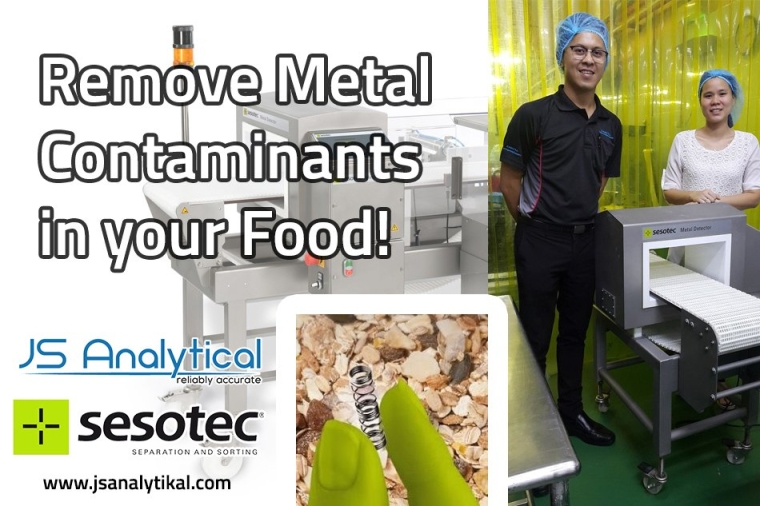
Brought to you by, JS Analytical Sdn Bhd (1094207-V)
Remove Metal Contaminants in Food / Packaging
'Ensure consumer safety by preventing contaminated food from reaching customers. Metal Detectors have played an important role of rejecting metal contaminated products while improvingproduction efficiency.'
Benefits :
- Prevent Production Machinery Damage caused by metal contaminants.
- Detection for Ferrous & Non-Ferrous Metal Particles such as Aluminium, Iron, Stainless steel, etc.
- Reduce Production Downtime.
- Less Customer Complaints.
- Less Product Recalls.
Solutions :
|
Metal Detector System with integrated conveyor belt |
Metal Detector System for Free-Fall Applications |
Very useful for sorting bulk produce like grains, rice, oats, seeds, dried food, raisins, etc.
- Can be easily intergrated into existing piping.
- Has high sensitivity to all metals and automatically remove metallic contaminants with the right reject system.
Metal detectors with conveyor belt can be use to detect metallic contaminants in food pieces, goods and packagings.
- All-in-one system that consist of a tunnel metal detector, a conveyor belt and optional reject mechanisms.
- They can be integrated without issue into existing production lines.
Why Sesotec?
From Germany and since 1976, Sesotec GmbH designs, manufactures, and markets inspection, separation, and sorting systems for manufacturing and processing industries.
Regardless of whether the contaminant − exposed or embedded in the product − is made of iron, steel, stainless steel or non-ferrous metals, such as aluminium, copper and brass, our metal detection systems identify all metallic contaminants using inductive technology

JS Analytical Sdn Bhd (1094207-V) is a Certified Agent for Sesotec GmbH.
For Consultation - Metal Detection Equipment :
Joe Yen, Product Specialist 012-6412576 (WhatsApp) / joeyen@obsnap.com
View original post here.
Why Measure Viscosity?
Feb 1, 2019|
Why Measure Viscosity?
The right viscosity ensures that flow rate of the product when traveling through the manufacturing process; how long it takes to reach and the
If toothpaste has high viscosity, too much paste will be pumped out and wasted; whille less viscosity may allow less wastage coming out from the tube. The same can be applied for tomato paste, crude oil, paint & ink, etc. How to Measure Viscosity?
( To determine a fluid's thickness and flow resistance using gravity. ) ( To Measure the viscosity of Newtonian and Non-Newtonian fluids. ) ( Assists with stirring and mixing for lower to higher viscosity fluids. ) ( Produces a rotating magnetic field, so that a magnetic stir bar will automatically stir the chemical solution or liquid. ) For consultation on QA/QC equipment: WhatsApp directly to +6018-221229 (direct link for mobile) Email back to emarketing@obsnap.com Please ensure you provide the following details:
And we will have our product specialised to contact you back for consultation & recommendation. Brought to you by, Obsnap Instruments Sdn Bhd (599642-A) OTHER SERVICES |







.jpg)





.jpg)




 Dehumidifier Dryers
Dehumidifier Dryers Dosing & Mixing
Dosing & Mixing











 Rockwell Hardness – Test Method
Rockwell Hardness – Test Method

















